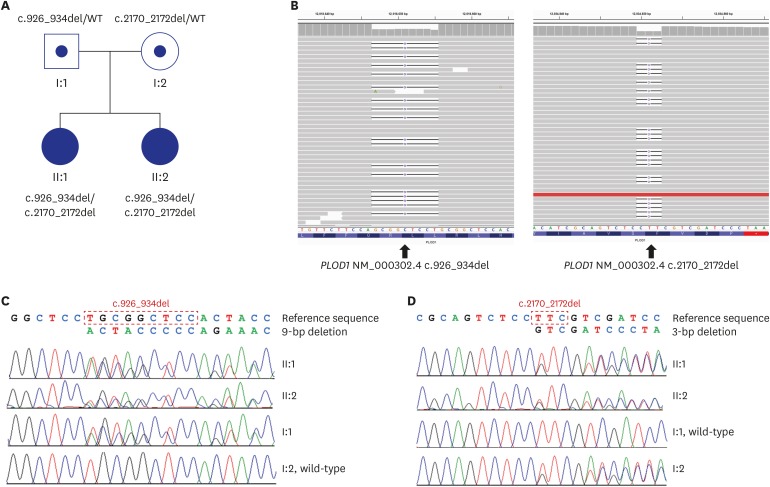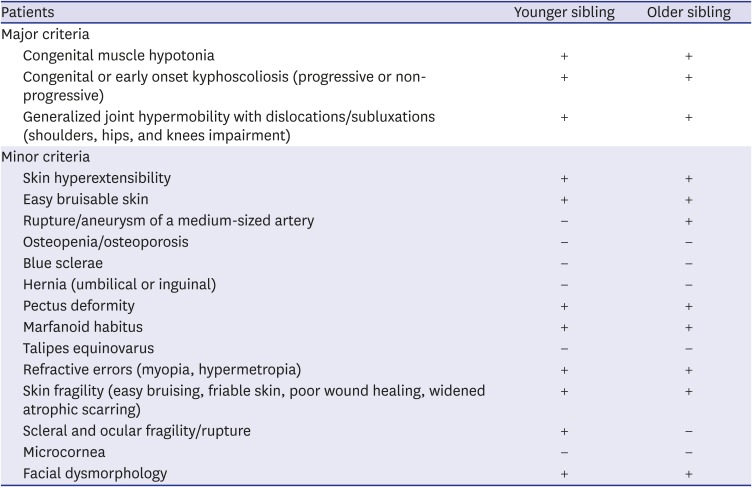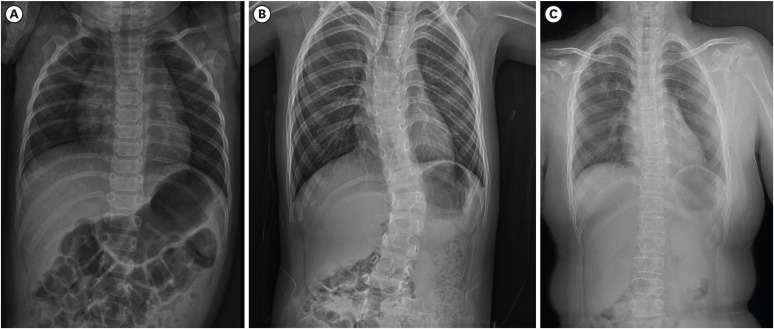1. Beighton P, De Paepe A, Steinmann B, Tsipouras P, Wenstrup RJ. Ehlers-Danlos National Foundation (USA) and Ehlers-Danlos Support Group (UK). Ehlers-Danlos syndromes: revised nosology, Villefranche, 1997. Am J Med Genet. 1998; 77(1):31–37. PMID:
9557891.

2. Krane SM, Pinnell SR, Erbe RW. Lysyl-protocollagen hydroxylase deficiency in fibroblasts from siblings with hydroxylysine-deficient collagen. Proc Natl Acad Sci U S A. 1972; 69(10):2899–2903. PMID:
4342967.

3. Pinnell SR, Krane SM, Kenzora JE, Glimcher MJ. A heritable disorder of connective tissue. Hydroxylysine-deficient collagen disease. N Engl J Med. 1972; 286(19):1013–1020. PMID:
5016372.
4. Rohrbach M, Vandersteen A, Yiş U, Serdaroglu G, Ataman E, Chopra M, et al. Phenotypic variability of the kyphoscoliotic type of Ehlers-Danlos syndrome (EDS VIA): clinical, molecular and biochemical delineation. Orphanet J Rare Dis. 2011; 6(1):46. PMID:
21699693.

5. Steinmann B, Eyre DR, Shao P. Urinary pyridinoline cross-links in Ehlers-Danlos syndrome type VI. Am J Hum Genet. 1995; 57(6):1505–1508. PMID:
8533783.
6. Brady AF, Demirdas S, Fournel-Gigleux S, Ghali N, Giunta C, Kapferer-Seebacher I, et al. The Ehlers-Danlos syndromes, rare types. Am J Med Genet C Semin Med Genet. 2017; 175(1):70–115. PMID:
28306225.

7. Baumann M, Giunta C, Krabichler B, Rüschendorf F, Zoppi N, Colombi M, et al. Mutations in FKBP14 cause a variant of Ehlers-Danlos syndrome with progressive kyphoscoliosis, myopathy, and hearing loss. Am J Hum Genet. 2012; 90(2):201–216. PMID:
22265013.

8. Yiş U, Dirik E, Chambaz C, Steinmann B, Giunta C. Differential diagnosis of muscular hypotonia in infants: the kyphoscoliotic type of Ehlers-Danlos syndrome (EDS VI). Neuromuscul Disord. 2008; 18(3):210–214. PMID:
18155911.

9. Giunta C, Randolph A, Al-Gazali LI, Brunner HG, Kraenzlin ME, Steinmann B. Nevo syndrome is allelic to the kyphoscoliotic type of the Ehlers-Danlos syndrome (EDS VIA). Am J Med Genet A. 2005; 133A(2):158–164. PMID:
15666309.

10. Tosun A, Kurtgoz S, Dursun S, Bozkurt G. A case of Ehlers-Danlos syndrome type VIA with a novel
PLOD1 gene mutation. Pediatr Neurol. 2014; 51(4):566–569. PMID:
25266621.
11. Malfait F, Francomano C, Byers P, Belmont J, Berglund B, Black J, et al. The 2017 international classification of the Ehlers-Danlos syndromes. Am J Med Genet C Semin Med Genet. 2017; 175(1):8–26. PMID:
28306229.
12. van Dijk FS, Mancini GM, Maugeri A, Cobben JM. Ehlers Danlos syndrome, kyphoscoliotic type due to Lysyl Hydroxylase 1 deficiency in two children without congenital or early onset kyphoscoliosis. Eur J Med Genet. 2017; 60(10):536–540. PMID:
28757364.

13. Hyland J, Ala-Kokko L, Royce P, Steinmann B, Kivirikko KI, Myllylä R. A homozygous stop codon in the lysyl hydroxylase gene in two siblings with Ehlers-Danlos syndrome type VI. Nat Genet. 1992; 2(3):228–231. PMID:
1345174.

14. Yeowell HN, Walker LC. Ehlers-Danlos syndrome type VI results from a nonsense mutation and a splice site-mediated exon-skipping mutation in the lysyl hydroxylase gene. Proc Assoc Am Physicians. 1997; 109(4):383–396. PMID:
9220536.
15. Yeowell HN, Allen JD, Walker LC, Overstreet MA, Murad S, Thai SF. Deletion of cysteine 369 in lysyl hydroxylase 1 eliminates enzyme activity and causes Ehlers-Danlos syndrome type VI. Matrix Biol. 2000; 19(1):37–46. PMID:
10686424.

16. Yeowell HN, Walker LC, Neumann LM. An Ehlers-Danlos syndrome type VIA patient with cystic malformations of the meninges. Eur J Dermatol. 2005; 15(5):353–358. PMID:
16172044.
17. Yeowell HN, Steinmann B. PLOD1-related Kyphoscoliotic Ehlers-Danlos syndrome. In : Adam MP, Ardinger HH, Pagon RA, Wallace SE, Bean LJH, Stephens K, editors. GeneReviews® [Internet]. Seattle (WA): University of Washington, Seattle;1993-2020.
18. Pousi B, Hautala T, Heikkinen J, Pajunen L, Kivirikko KI, Myllylä R. Alu-Alu recombination results in a duplication of seven exons in the lysyl hydroxylase gene in a patient with the type VI variant of Ehlers-Danlos syndrome. Am J Hum Genet. 1994; 55(5):899–906. PMID:
7977351.
19. Loenarz C, Schofield CJ. Physiological and biochemical aspects of hydroxylations and demethylations catalyzed by human 2-oxoglutarate oxygenases. Trends Biochem Sci. 2011; 36(1):7–18. PMID:
20728359.







 PDF
PDF Citation
Citation Print
Print




 XML Download
XML Download